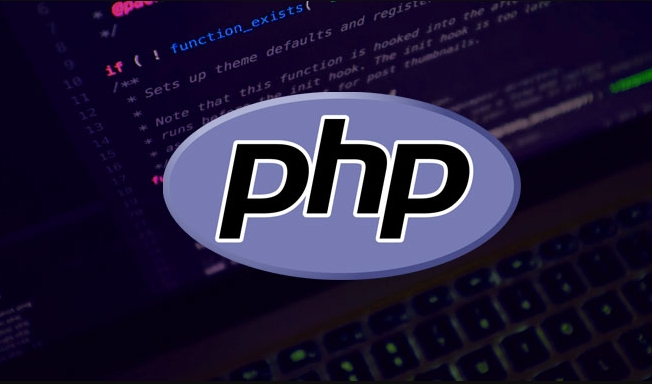date_modify is a method in PHP used to modify the date and time represented by the DateTime object, allowing addition and subtraction of dates. 1. Its basic usage is to adjust the date by passing string parameters such as 1 day or -2 months; 2. It can be used in combination with multiple time units, such as 1 week 2 days, which is suitable for periodic task arrangement; 3. It supports natural language expression, such as next Monday, which is convenient for user input; 4. When using it, you need to pay attention to directly modifying the original object, the object should be cloned to retain the original value, and pay attention to boundary situations such as the end of the month.

The date_modify function in PHP is a very practical time processing tool, especially when it is necessary to increase or decrease the date. It allows you to flexibly adjust time values ??based on existing dates.

What is date_modify ?
date_modify is a method in PHP to modify the date and time represented by the DateTime object. You can use it to increase or decrease days, hours, months, etc. Its basic usage is as follows:

$date = new DateTime('2024-01-01'); $date->modify(' 1 day'); echo $date->format('Ym-d'); // Output 2024-01-02
This function takes a string parameter and describes the modification you want to make, such as 1 week or -3 days , which is very intuitive.
Common usage and techniques
1. Modify the basic format of the date
The most basic and common ones are adding and subtracting days, months or years. For example:

-
1 day -
-2 months -
3 years
These can be directly passed to modify() method, which is suitable for calendar functions, countdowns, reminders and other functions.
Example:
$date = new DateTime(); $date->modify(' 5 days'); echo 'Five days later is:' . $date->format('Ym-d');
2. Combined with time units
You can also modify multiple units at once, such as the writing method of "adding one week and two days" is also supported:
$date->modify(' 1 week 2 days');
This method is very suitable for handling scheduling of cyclical tasks, such as tasks that are executed once a Wednesday, and it is easy to calculate the next execution time in this way.
3. Process relative time (such as next Monday)
In addition to adding and subtracting numbers, you can also use natural language expressions, such as:
-
next Monday -
last Friday -
tomorrow -
yesterday
This is helpful for processing time descriptions of user input.
Example:
$date = new DateTime(); $date->modify('next Monday'); echo 'Next Monday date is:' . $date->format('Ym-d');
Things to note
There are several details that are easy to ignore when using date_modify :
- It directly modifies the original object , rather than returning a new DateTime instance.
- If you want to keep the original object unchanged, remember to clone it first:
$newDate = clone $date; $newDate->modify(' 1 day');
- Pay attention to the end of the month when using operations like
1 month. For example, from March 31 to add one month, the result may be May 1, instead of April 30.
Let's summarize
The core value of date_modify is that it allows you to flexibly manipulate dates without manually calculating timestamps. Whether it is doing simple addition and subtraction, or handling complex time logic, it is competent. Just pay attention to its side effects (modify the original object) and some boundary situations, and it will be easy to use.
Basically that's all, not complicated but quite practical.
The above is the detailed content of php date modify. For more information, please follow other related articles on the PHP Chinese website!

Hot AI Tools

Undress AI Tool
Undress images for free

Undresser.AI Undress
AI-powered app for creating realistic nude photos

AI Clothes Remover
Online AI tool for removing clothes from photos.

Clothoff.io
AI clothes remover

Video Face Swap
Swap faces in any video effortlessly with our completely free AI face swap tool!

Hot Article

Hot Tools

Notepad++7.3.1
Easy-to-use and free code editor

SublimeText3 Chinese version
Chinese version, very easy to use

Zend Studio 13.0.1
Powerful PHP integrated development environment

Dreamweaver CS6
Visual web development tools

SublimeText3 Mac version
God-level code editing software (SublimeText3)

Hot Topics
 What are some best practices for versioning a PHP-based API?
Jun 14, 2025 am 12:27 AM
What are some best practices for versioning a PHP-based API?
Jun 14, 2025 am 12:27 AM
ToversionaPHP-basedAPIeffectively,useURL-basedversioningforclarityandeaseofrouting,separateversionedcodetoavoidconflicts,deprecateoldversionswithclearcommunication,andconsidercustomheadersonlywhennecessary.StartbyplacingtheversionintheURL(e.g.,/api/v
 How do I implement authentication and authorization in PHP?
Jun 20, 2025 am 01:03 AM
How do I implement authentication and authorization in PHP?
Jun 20, 2025 am 01:03 AM
TosecurelyhandleauthenticationandauthorizationinPHP,followthesesteps:1.Alwayshashpasswordswithpassword_hash()andverifyusingpassword_verify(),usepreparedstatementstopreventSQLinjection,andstoreuserdatain$_SESSIONafterlogin.2.Implementrole-basedaccessc
 What are the differences between procedural and object-oriented programming paradigms in PHP?
Jun 14, 2025 am 12:25 AM
What are the differences between procedural and object-oriented programming paradigms in PHP?
Jun 14, 2025 am 12:25 AM
Proceduralandobject-orientedprogramming(OOP)inPHPdiffersignificantlyinstructure,reusability,anddatahandling.1.Proceduralprogrammingusesfunctionsorganizedsequentially,suitableforsmallscripts.2.OOPorganizescodeintoclassesandobjects,modelingreal-worlden
 What are weak references (WeakMap) in PHP, and when might they be useful?
Jun 14, 2025 am 12:25 AM
What are weak references (WeakMap) in PHP, and when might they be useful?
Jun 14, 2025 am 12:25 AM
PHPdoesnothaveabuilt-inWeakMapbutoffersWeakReferenceforsimilarfunctionality.1.WeakReferenceallowsholdingreferenceswithoutpreventinggarbagecollection.2.Itisusefulforcaching,eventlisteners,andmetadatawithoutaffectingobjectlifecycles.3.YoucansimulateaWe
 How can you handle file uploads securely in PHP?
Jun 19, 2025 am 01:05 AM
How can you handle file uploads securely in PHP?
Jun 19, 2025 am 01:05 AM
To safely handle file uploads in PHP, the core is to verify file types, rename files, and restrict permissions. 1. Use finfo_file() to check the real MIME type, and only specific types such as image/jpeg are allowed; 2. Use uniqid() to generate random file names and store them in non-Web root directory; 3. Limit file size through php.ini and HTML forms, and set directory permissions to 0755; 4. Use ClamAV to scan malware to enhance security. These steps effectively prevent security vulnerabilities and ensure that the file upload process is safe and reliable.
 What are the differences between == (loose comparison) and === (strict comparison) in PHP?
Jun 19, 2025 am 01:07 AM
What are the differences between == (loose comparison) and === (strict comparison) in PHP?
Jun 19, 2025 am 01:07 AM
In PHP, the main difference between == and == is the strictness of type checking. ==Type conversion will be performed before comparison, for example, 5=="5" returns true, and ===Request that the value and type are the same before true will be returned, for example, 5==="5" returns false. In usage scenarios, === is more secure and should be used first, and == is only used when type conversion is required.
 How can you interact with NoSQL databases (e.g., MongoDB, Redis) from PHP?
Jun 19, 2025 am 01:07 AM
How can you interact with NoSQL databases (e.g., MongoDB, Redis) from PHP?
Jun 19, 2025 am 01:07 AM
Yes, PHP can interact with NoSQL databases like MongoDB and Redis through specific extensions or libraries. First, use the MongoDBPHP driver (installed through PECL or Composer) to create client instances and operate databases and collections, supporting insertion, query, aggregation and other operations; second, use the Predis library or phpredis extension to connect to Redis, perform key-value settings and acquisitions, and recommend phpredis for high-performance scenarios, while Predis is convenient for rapid deployment; both are suitable for production environments and are well-documented.
 How do I perform arithmetic operations in PHP ( , -, *, /, %)?
Jun 19, 2025 pm 05:13 PM
How do I perform arithmetic operations in PHP ( , -, *, /, %)?
Jun 19, 2025 pm 05:13 PM
The methods of using basic mathematical operations in PHP are as follows: 1. Addition signs support integers and floating-point numbers, and can also be used for variables. String numbers will be automatically converted but not recommended to dependencies; 2. Subtraction signs use - signs, variables are the same, and type conversion is also applicable; 3. Multiplication signs use * signs, which are suitable for numbers and similar strings; 4. Division uses / signs, which need to avoid dividing by zero, and note that the result may be floating-point numbers; 5. Taking the modulus signs can be used to judge odd and even numbers, and when processing negative numbers, the remainder signs are consistent with the dividend. The key to using these operators correctly is to ensure that the data types are clear and the boundary situation is handled well.






